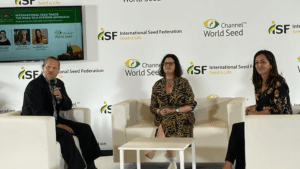A Deep Dive into the Multilateral Systems Approach
WHY IT MATTERS: Moving seed around the world can be a headache. One of the major hurdles to overcome are the many and often diverging national phytosanitary regulations. Each country has a different set of requirements. These regulatory differences put a strain on companies in terms of resources to meet all those requirements, and cause delays and even rejections of seed shipments.
In an attempt to harmonize and simplify international movement of seed, the seed sector came up with an alternative for the current complex way of working called a Multilateral Systems Approach. To learn more about the benefits of such an approach for the various stakeholders in the seed supply chain, European Seed sat down with Isabel Bezuidenhout, phytosanitary manager at the South African Seed Organization (SANSOR), Merel Langens, global manager industry affairs at BASF’s vegetable seeds business and chair of the International Seed Federation (ISF) Systems Approach Expert Group, and Rose Souza Richards, seed health manager at ISF.
Diverging Phytosanitary Regulations
International standards and guidelines, established by the International Plant Protection Convention (IPPC), provide a common framework for harmonizing phytosanitary measures and promoting consistency. The IPPC aims to facilitate safe trade while minimizing unnecessary trade barriers. “However, due to the complex nature of plant health and the varying pest profiles across countries, it is not always possible to achieve complete harmonization,” says Bezuidenhout. Another factor that hampers complete harmonization is the fact that IPPC-agreements are often bilateral, between two countries. For the international seed industry, a multilateral recognized framework would be most suitable.
An important principle in the agreement of the IPPC is that countries have sovereign authority. This means that each country can prescribe the phytosanitary measures that are deemed necessary to protect plant health within their own country. Each country assesses the pest risk connected to import of seeds, and decisions about import requirements are made based on this risk and on the ‘appropriate level of protection’ (ALOP) as determined by the country. “This has led to the current situation in which there is no harmonization of phytosanitary import requirements. For example, there are approx. 28 countries that have implemented, more or less, different import requirements to ensure absence of Tomato Brown Rugose Fruit Virus (ToBRFV) on tomato seeds. This makes it very tedious and complex for seed companies to ship a seed lot to several countries as requirements of all countries have to be fulfilled (field inspection, seed treatment, testing using different techniques, etc.),” says Langens.

The Agreement on the Application of Sanitary and Phytosanitary Measures (SPS) of the World Trade Organization (WTO) and the IPPC allow countries to impose phytosanitary regulations to protect plant health but qualify that all measures must be based on a pest risk assessment or recommended international standards. “The main aim of these regulations is to protect domestic agriculture and natural resources from potential threats posed by the introduction of pests and diseases through international trade. The seed industry has noticed a rapid increase of diverging phytosanitary requirements by National Plant Protection Organisations (NPPOs) over the past years with an emerging trend of specific requirements for each pest,” says Bezuidenhout.
Souza Richards explains that the implementation of diverging phytosanitary regulations among countries can be attributed to several factors. “Phytosanitary regulations are measures designed to protect plant health and prevent the spread of pests and diseases that can harm agricultural crops, forests, and natural ecosystems,” she says. While the overarching goals of regulations are the same, there can be variations in how countries approach these regulations for several reasons:
- National Priorities: Each country has its own unique set of agricultural, environmental, and economic priorities. Phytosanitary regulations are often tailored to address specific risks and challenges faced by a particular country. For example, a country heavily reliant on a specific crop might have stricter regulations to protect against pests that could devastate that crop.
- Risk Assessments: Phytosanitary regulations are typically based on scientific risk assessments conducted by NPPOs or regulatory bodies. However, the interpretation and application of scientific data can vary. Different countries may have different risk tolerance levels or interpret the available scientific evidence differently.
- Regional Considerations: Countries often collaborate within regional frameworks to harmonize phytosanitary measures. Regional organizations such as the European Plant Protection Organization (EPPO), the North American Plant Protection Organization (NAPPO), or the Asia-Pacific Plant Protection Commission (APPPC) work towards aligning regulations within their respective regions. However, even within regional frameworks, there may still be variations due to specific country circumstances or differing scientific perspectives.
- Trade Considerations: Phytosanitary regulations are also influenced by international trade considerations. Countries may adopt regulations to protect their domestic agricultural industries from the introduction of pests and diseases through imported goods. These regulations can be more stringent or deviate from scientific consensus to safeguard national interests.
Non-science-based regulations are problematic for multiple reasons. “Increased phytosanitary regulation that takes a non-science-based approach contradicts international standards and agreements. Additionally, these increasing regulations significantly add to the costs and impact the ability of seed companies to get seed to farmers when they need it,” says Bezuidenhout.
While the intent of phytosanitary regulations is to be based on scientific data and risk assessment, differences in interpretation, local conditions, and priorities can result in varying measures between countries. Harmonizing these regulations and promoting international cooperation continue to be ongoing challenges in facilitating safe global trade.
An Alternative: Multilateral Systems Approach
Souza Richards clarifies that a multilateral Systems Approach (SA) could be applied as an alternative to the current phytosanitary certification. “A multilateral SA is a coordinated and harmonized framework designed to minimize the risks associated with the international trade of plants and plant products implemented by multiple — more than two — countries. It involves a systematic and science-based approach that considers all activities during the entire production and supply chain, from the source to the destination, to ensure the safe movement of seed while reducing the spread of pests and diseases,” she adds.
Under a multilateral SA, seed companies can be certified as producing pest-free seeds based on their hygiene practices and protocols. The certification is done by the authorities of the country in which the seed is produced and is recognized by the other countries in the agreement, preferably as many as possible. “Certified companies can ship seeds in a more predictable way between countries that recognize the system,” says Langens. “And collaboration with the IPPC would be the best way to achieve harmonization” she adds.

The overall objective of a multilateral SA is to facilitate safe international trade while effectively managing phytosanitary risks. “By implementing a harmonized approach that considers the entire production and supply chain, countries can minimize the introduction and spread of pests and diseases, protect their own agricultural systems, and contribute to global plant health security,” explains Souza Richards.
“This approach can enhance global trade while ensuring the protection of domestic agriculture, natural resources, and biosecurity,” adds Bezuidenhout.
Benefits of a Systems Approach
The increase in trade and in phytosanitary requirements increasingly put a strain on NPPO’s resources. “A [multilateral] SA would reduce that strain as it is a harmonized alternative to consignment-by-consignment testing. The role of the NPPO would change to overseeing the system, which empowers them to fulfil their mandate more effectively,” says Langens. With ISPM45 ‘Requirements for national plant protection organizations if authorizing entities to perform phytosanitary actions’ being published, NPPOs could also consider authorizing entities to support the auditing.
She adds that a SA would make risk assessment by NPPOs easier as guidance would be provided on the pests for which seed is a pathway. “Also, there would be suggestions for risk mitigation measures. As SA is an alternative to the current system and not a replacement, the sovereign authority of countries would not be compromised.

In a pilot study, it is currently tested as to whether it is possible to have an agreement between NPPOs of four countries regarding a list of relevant pests and a base line set of mitigation measures for one crop. This is a first step to show that multilateral acceptance is feasible,” she says.
In addition to the benefits above, Bezuidenhout underlines that a SA would provide a long-term solution to the current patchwork of phytosanitary certification that currently differs by country. As such, it would give a more efficient and predictable framework for the international movement of seed; would lead to global harmonization of regulated pests per crop that would facilitate more efficient re-export; would reduce the workload for NPPOs as they will overseeing the system instead of the requirements for each and every consignment, and it would allow more pro-actively addressing of emerging pathogens.
“It would also protect domestic agriculture,” says Souza Richards. “By managing phytosanitary risks through a systems approach, a country can protect its own agriculture and natural resources from the introduction and spread of pests and diseases. This helps safeguard the country’s food security, environment and economy.”
Apart from these benefits, a SA is also beneficial for collaboration and information sharing. Implementing a SA often requires clear communication between and the joint efforts of multiple stakeholders, including government agencies, industry partners, and international organizations. A SA requires cooperation, knowledge exchange, and capacity building, which can benefit the overall phytosanitary system of the country.
By embracing a SA, countries can strengthen their phytosanitary systems, protect their agricultural industries, promote international trade, and contribute to global efforts in ensuring plant health security.












